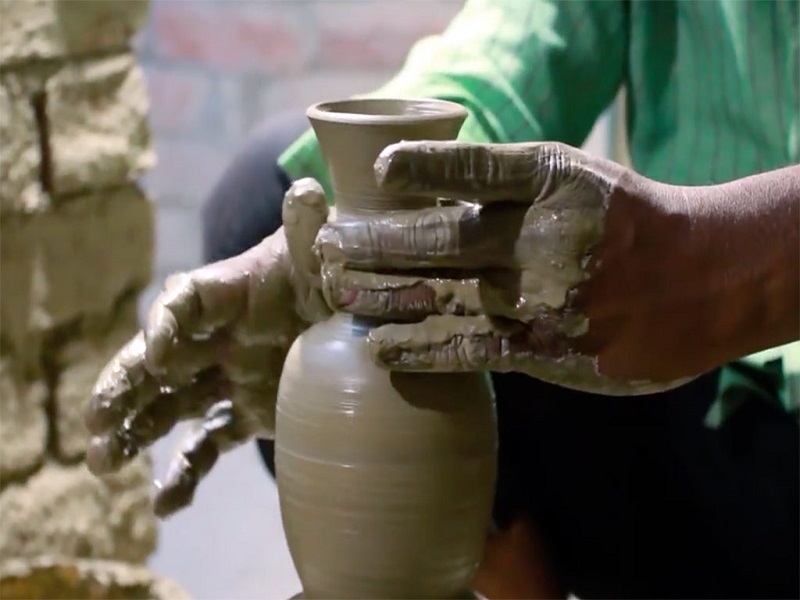Black pottery, known for its unique luster and fine craftsmanship, originates from Nizamabad in Telangana state. Artisans use a traditional method of firing clay with natural dyes, producing a striking black sheen. This ancient craft blends artistry and functionality, creating exquisite designs that have stood the test of time.
Remember the time when at the mere age of 8 and had visited grandmother’s village in the Western part of Maharashtra. The village, like any regular village, was small in size and not exactly convenient to suit the needs of a city dweller; but the experiences that a village has to provide are surely not found elsewhere. Out of the many fascinating things that witnessed in the village, the one which stuck with me to date is the memory of the village potters. Sitting amidst a crowd of many, the potter would expertly handle the wet clay and would shape them to form beautiful pots on the exquisite potter’s wheel.
The Black Pottery of Nizamabad, situated in Uttar Pradesh, is magic on its own. With alluring silver designs on the body of the pot and a shiny texture, many people are simply in awe of this spectacular piece of art.
History of Black Pottery in Nizamabad
Even though Uttar Pradesh has a metaphorical ‘patent’ in terms of Black pottery, it would astound many to know that this art form originally was founded in the state of Gujrat. Sources confirm that during the reign of the infamous ruler Aurangzeb, several artists left the Kutch region and migrated to Nizamabad. Other people talk about the possible involvement of Hyderabad in this as well. This premise is supported by the fact that the silver patterns on the ware are identical to the kind in Bidriware, Hyderabad. Even though history remains uncertain, the very fact that this amazing art form has originated in India is enough to mitigate all doubts.
The Process of Black Pottery
- STAGE 1 – Just like they say that the love of a mother flows into her food, the earth of Nizamabad pours its love into its pots. The fine texture and high mica content of the soil of Nizamabad make it the perfect choice for pottery. The soil is the reason why these pots attain the desirable texture and flawless quality that they are known to possess.
- STAGE 2 – During the early months of April-May, potters make sure to initiate the process of extracting clay from their local ponds, they follow that up by immediately storing it in their houses for long periods. Eventually, the stored clay is mixed with water and once the clay thickens, it is thoroughly kneaded by machines. This is done to free the clay of any impending lumps which may cause obstacles in the long run. Soon after this, the potters bring the clay out to the potter’s wheel and begin their magic.
- STAGE 3 – Even though the pots are made, the process of pottery is far from over. Next, the potters leave their pots out in the scorching sun to let them dry out and retain moisture. After drying sufficiently, the potter’s wheel is pulled back out to scrape off any uneven or unwanted layer. Following this comes the part of applying color to the otherwise dull pots. The pots are left out in the sun after applying a coat of mixed water and clay to them. This stage finally terminates after applying mustard to the pots to make them appear shinier.
- STAGE 4 – Now as we approach the end of pottery making, women use fine needles to cautiously engrave delicate designs and patterns on the pots. They make use of brilliant craftsmanship practiced for many years to achieve this level of precision. The pots are then put in the oven to bake. One important factor that decides the fate of the pot is oxygen. Potters must ensure that the level of oxygen in the pots must remain low to none if they want to achieve the black color that these pots are so famous for. After a few more steps, you have yourself a wonderful piece of art to take home!
If you are an avid collector of art, you’ll be pleased to know that multiple wares are available in the Black pottery. Both household and ornamental goods are available to consumers in the form of plates, lamps, vessels, bowls, vases, and a long water pot known as Surahi. A splendid selection of religious figures is famous amongst tourists as well. This includes statues of various Hindu deities. After noticing an unfortunate decreasing trend in the number of people engaged in this profession, the government has taken several steps to revive the lost growth. With the advent of technology, the increase global tie-ups have also significantly increased. Now, more and more youngsters are returning to the pottery business due to the involvement of big MNC like Amazon and Flipkart, who aid these businesses by bringing their products online.
With the help of government intervention and much-needed self-awareness in people, the local arts of India are thriving and will soon be in full bloom again. India is blessed with many such exuberant and colorful craftsmanship which should certainly be cherished and celebrated by us. #hydkhabar

